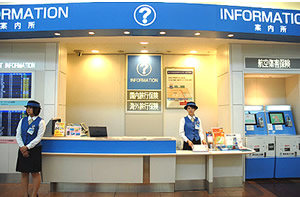New Haneda Airport Terminals, Tokyo, Based on Universal Design Principles
Share on social media
Tokyo's new Haneda Airport passenger terminals, opened in October 2010, are based on universal design in accordance with the barrier-free concept to ensure convenience in use of facilities.
 Photo of passenger information desk. Japan Airport Terminal Co.
Photo of passenger information desk. Japan Airport Terminal Co.
Tokyo's new Haneda Airport passenger terminals, opened in October 2010, are based on universal design in accordance with the barrier-free concept to ensure convenience in use of facilities.
Terminals are subject to a process of continual development to ensure constant improvement of terminals on this basis.
Haneda Airport provides qualified assistance staff skilled in support for older persons and passengers with disabilities.
Passengers requiring assistance are requested to contact the nearest information desk, or hail an airport 'Passenger Support Person'.
The facilities are described in the "Barrier-Free" section of the airport website. The "Barrier-Free" webpages are easy to find, as they are accessed through a link which is placed at the top and centre of the Haneda Airport website's main page.
Review
A review of Haneda International Passenger Terminal was published by The Independent, on 24 April 2011. The text of the review is provided below:
"The universal design principles incorporated into the passenger areas at Haneda Airport's new international terminal have been acclaimed as world class and can serve as a blueprint for integrated "barrier-free" facilities in similar facilities around the world.
So much thought has gone into the design of the airport, which serves Tokyo, that it even has dedicated indoor toilet facilities for people who are accompanied by a guide dog.
Tokyo International Air Terminal Corp. said in a statement that it has endeavored to make the new terminal as user-friendly as possible, "incorporating the principles of universal design so that every customer can make use of our facilities easily and with peace of mind."
The operator of the airport set up a design committee in the earliest planning stages, including people with disabilities - ranging from wheelchair users to people with vision and hearing impairments - as well as representatives of airlines and railway companies that serve the airport.
One of the biggest debates was over the design of the toilets for people who need assistance from a helper. A problem the designers encountered was with automatic doors that open when the user approaches, but can also be triggered by the helper and expose the person on the toilet.
The panel eventually opted to use doors that are opened manually but are made of very lightweight material to make them easier to open and close.
Emergency buttons in the elevators are designed for people with hearing impairments and, because an intercom system cannot help them, airport employees trained in sign language are immediately dispatched to the elevator.
Similarly, the terminal's arrivals and departures boards use clearer fonts and larger text than are used in other airports, while information counters also have message boards for hearing-impaired travelers and staff to communicate. Maps of the facilities are also provided in braille
The terminal also has a number of state-of-the-art mobility carts to transfer people with physical disabilities, the elderly or people traveling with young people, while the airport is also the first in the world to incorporate boarding bridges that do not slope up or down for passengers.
The designers have also tried to make the experience of using the airport easier for other passengers, with 85 staff on hand at information counters, all of whom speak English and many also able to communicate in Chinese and Korean."
